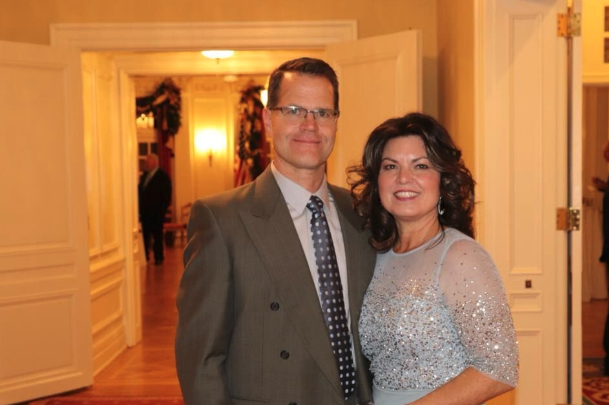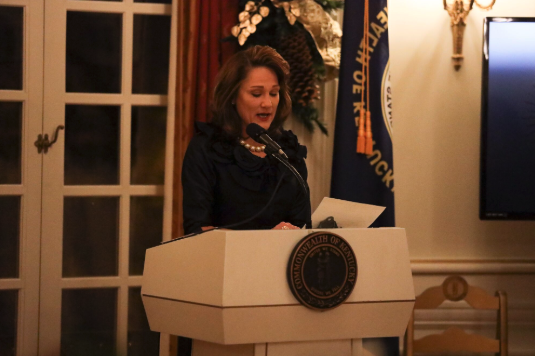Kentucky Nonprofit Working to Open State’s First Shelter for Sexually Trafficked and Exploited Children
Writer / Noelle Tennis Gulden
 When Cara Starns attended a session on child victims of human trafficking during a regional conference last year, she had no idea it would alter the course of her life.
When Cara Starns attended a session on child victims of human trafficking during a regional conference last year, she had no idea it would alter the course of her life.
“It just so happens that I was sitting next to a child trafficking detective from the state during the session,” Starns says.
When the presenter revealed that Kentucky had no shelter specifically and solely designed to serve sexually exploited and trafficked children, Starns says, “The detective elbowed me and said, ‘Did you hear that?’”
Even though human trafficking had been at the center of her career from the very beginning, Starns, who had recently returned home to Kentucky to develop a Refuge for Women site in Louisville, was shocked to hear that no shelters existed in Kentucky for trafficked children — especially since the Kentucky Cabinet for Health and Family Services reports that there have been 787 reported incidents of child sex trafficking in Kentucky since 2013, involving 949 alleged victims.
Still, Starns says, “My first reaction was, ‘What does this have to do with me?’” As far as she was concerned, her work had not changed — it was still to open a Refuge for Women site in Louisville.
Before long, however, that elbow nudge from the detective turned into an internal nudge Starns couldn’t ignore. She spent six months conducting research on what it would take for Refuge for Women to open a children’s shelter in Kentucky.
Her conclusion was clear, if not disappointing.
“I determined that a shelter for sexually exploited and trafficked children would have to be its own thing,” Starns says. “Refuge for Women couldn’t do it.”
When Cara presented her research findings to the national board of Refuge for Women, she thought it was the end of the matter, an inquiry she would ultimately put behind her.
“They told me that if I wanted to take it on, they would support me,” she says.
This was the second nudge, which was quickly followed by a third.
“A family foundation called and told us they would provide seed funding if we decided to move ahead with the project,” Starns says.
Despite all these nudges, Starns knew she was up against tough odds. Several other groups had tried to open shelters for sexually exploited and trafficked children in the past, and each attempt had failed. She had no reason to believe her efforts would be any different than previous ones. Starns decided to continue moving forward, however, and others soon decided to join her.
What started as one woman’s research project quickly developed into a nonprofit organization called Safe Passage, whose mission is “working to open Kentucky’s first shelter for sexually trafficked and exploited children.”
In addition to Starns, who serves as the organization’s founder and president, Safe Passage is led by a seven-member board of directors, one of who is a survivor of childhood exploitation.
“They’ve partnered with me in our absolute hardest stage,” Starns says. “Building from absolutely nothing.”
Even though Safe Passage is less than a year old, they have already raised over $150,000 toward their fundraising goal of $200,000 this year. While Starns is proud of this accomplishment, she knows they have a long way to go toward sustainability.
“The shelter will cost half a million dollars each year to run,” she says. She hopes to be able to open the shelter by 2021. Safe Passage will not be eligible for government funding until after the shelter has opened, so the organization is currently focused on raising support from monthly donors and foundations.
When it is open, the shelter will provide holistic aftercare to child victims of sexual exploitation and trafficking. The residential program will be geared toward girls aged 12-17 and will last up to 12 months. Comprehensive, evidence-based, and trauma-informed services will be provided in an environment designed to encourage residents to rebuild safety, trust, and community.
Outpatient services, such as therapy, classes, and case-management, will be available to victims who have a safe place to return. Trafficked boys will also be eligible for outpatient services, and caregivers of trafficked children will be able to receive support services that will equip them to partner with the child in their recovery.
 The fact that the shelter won’t open for a couple more years hasn’t kept Safe Passage from finding other ways to address child sex trafficking in the meantime. Safe Passage currently offers a youth prevention program for students across the state called “Raise the Standard.”
The fact that the shelter won’t open for a couple more years hasn’t kept Safe Passage from finding other ways to address child sex trafficking in the meantime. Safe Passage currently offers a youth prevention program for students across the state called “Raise the Standard.”
The program, which was founded under Refuge for Women, has two main sessions: sexual abuse and human trafficking.
“We do both because all of our human trafficking victims have been sexually abused before,” she says. “The sexual abuse session is heavy because it’s not just preventative, it’s an intervention.” According to the Kentucky Cabinet for Health and Family Services, one in four girls and one in six boys will be sexually abused before they turn 18, meaning that in any given session, presenters are likely speaking to several children who have been abused themselves.
The human trafficking session, by contrast, is more preventative.
“Most of the time, if people are trafficked, they’ve already left school,” Starns says.
Safe Passage is working on developing training for foster parents on how to recognize the signs of child sex trafficking and how to intervene. According to the Safe Passage website, “94% of [victims of sex trafficking] already have a history with child welfare.”
Starns hopes to begin offering the training as soon as next year.
Starns knows that the level of comprehensive prevention and support Safe Passage will offer is needed now more than ever.
“Trafficking children has never been easier,” she says. “Traffickers pull up their phone and get on Instagram or Snapchat, message 100 kids, and are just looking for one to respond, is snapchat location accurate. It’s never been easier with social media. After several months of grooming, a child ends up leaving their house of their own will.
Despite the somber urgency of her work, Starns is quick to point out the importance of maintaining hope in the midst of it all. “We do everything through the lens of hope,” she says. “We want the people we engage with to feel like they can change things — I can change my life, and I can change my community.”
If you or someone you know is a minor who has been sexually trafficked or exploited and is in need of help now, you can find nearby resources in the National Human Trafficking Hotline’s Referral Directory: humantraffickinghotline.org/training-resources/referral-directory
How You Can Help Child Victims of Sex Trafficking
Safe Passage offers several ways for people to help them in their efforts to prevent child sex trafficking and help trafficking victims find healing.
- Donate to Safe Passage: safepassageky.org/donate. Monthly supporters help Safe Passage plan for sustainability.
- Invite Safe Passage to speak to your student group about sexual abuse and human trafficking: safepassageky.org/prevention
- Volunteer with Safe Passage: safepassageky.org/volunteer
- Gift Safe Passage with one or more of the items on their wish list: safepassageky.org/wish-list







Comments 1
Due to my husband’s health, I feel that I need to not attend your lunch in February. But I am very interested in your organization, and I would like to help your group when I can. I will be sending a donation – fairly small amounts at various times. Please send me any additional information about volunteer opportunities. Thank you.